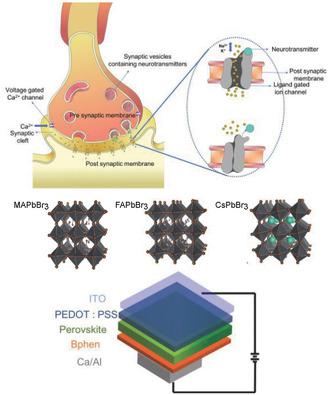当前位置:
X-MOL 学术
›
Adv. Mater.
›
论文详情
Our official English website, www.x-mol.net, welcomes your feedback! (Note: you will need to create a separate account there.)
Ionotronic Halide Perovskite Drift‐Diffusive Synapses for Low‐Power Neuromorphic Computation
Advanced Materials ( IF 29.4 ) Pub Date : 2018-10-17 , DOI: 10.1002/adma.201805454 Rohit Abraham John 1 , Natalia Yantara 2 , Yan Fong Ng 1, 2 , Govind Narasimman 3 , Edoardo Mosconi 4, 5 , Daniele Meggiolaro 4, 5 , Mohit R. Kulkarni 1 , Pradeep Kumar Gopalakrishnan 3 , Chien A. Nguyen 1 , Filippo De Angelis 4, 5 , Subodh G. Mhaisalkar 1, 2 , Arindam Basu 3 , Nripan Mathews 1, 2
Advanced Materials ( IF 29.4 ) Pub Date : 2018-10-17 , DOI: 10.1002/adma.201805454 Rohit Abraham John 1 , Natalia Yantara 2 , Yan Fong Ng 1, 2 , Govind Narasimman 3 , Edoardo Mosconi 4, 5 , Daniele Meggiolaro 4, 5 , Mohit R. Kulkarni 1 , Pradeep Kumar Gopalakrishnan 3 , Chien A. Nguyen 1 , Filippo De Angelis 4, 5 , Subodh G. Mhaisalkar 1, 2 , Arindam Basu 3 , Nripan Mathews 1, 2
Affiliation

|
Emulation of brain‐like signal processing is the foundation for development of efficient learning circuitry, but few devices offer the tunable conductance range necessary for mimicking spatiotemporal plasticity in biological synapses. An ionic semiconductor which couples electronic transitions with drift‐diffusive ionic kinetics would enable energy‐efficient analog‐like switching of metastable conductance states. Here, ionic–electronic coupling in halide perovskite semiconductors is utilized to create memristive synapses with a dynamic continuous transition of conductance states. Coexistence of carrier injection barriers and ion migration in the perovskite films defines the degree of synaptic plasticity, more notable for the larger organic ammonium and formamidinium cations than the inorganic cesium counterpart. Optimized pulsing schemes facilitates a balanced interplay of short‐ and long‐term plasticity rules like paired‐pulse facilitation and spike‐time‐dependent plasticity, cardinal for learning and computing. Trained as a memory array, halide perovskite synapses demonstrate reconfigurability, learning, forgetting, and fault tolerance analogous to the human brain. Network‐level simulations of unsupervised learning of handwritten digit images utilizing experimentally derived device parameters, validates the utility of these memristors for energy‐efficient neuromorphic computation, paving way for novel ionotronic neuromorphic architectures with halide perovskites as the active material.
中文翻译:

电离卤化物钙钛矿漂移扩散突触,用于低功率神经形态计算
模拟类脑信号处理是开发高效学习电路的基础,但是很少有设备能够提供模拟生物突触时空可塑性所需的可调电导范围。离子半导体将电子跃迁与漂移扩散的离子动力学耦合在一起,将能够实现亚稳态电导状态的高能效类模拟转换。在这里,卤化钙钛矿半导体中的离子-电子耦合被用来创建具有电导态动态连续过渡的忆阻突触。钙钛矿薄膜中载流子注入势垒和离子迁移的共存定义了突触可塑性的程度,与无机铯对应物相比,较大的有机铵和甲ami阳离子更引人注目。优化的脉冲方案可促进短期和长期可塑性规则之间的平衡相互作用,例如成对脉冲促进和依赖于尖峰时间的可塑性,是学习和计算的主要方法。卤化物钙钛矿突触被训练成记忆阵列,与人类大脑类似,具有可重构性,学习性,遗忘性和容错性。利用实验得出的设备参数对手写数字图像进行无监督学习的网络级仿真,验证了这些忆阻器在高能效神经形态计算中的实用性,为卤化钙钛矿为活性材料的新型电离神经形态体系结构铺平了道路。卤化物钙钛矿突触被训练成记忆阵列,与人类大脑类似,具有可重构性,学习性,遗忘性和容错性。利用实验得出的设备参数对手写数字图像进行无监督学习的网络级仿真,验证了这些忆阻器在高能效神经形态计算中的实用性,为卤化钙钛矿为活性材料的新型电离神经形态体系结构铺平了道路。卤化物钙钛矿突触被训练成记忆阵列,与人类大脑类似,具有可重构性,学习性,遗忘性和容错性。利用实验得出的设备参数对手写数字图像进行无监督学习的网络级仿真,验证了这些忆阻器在高能效神经形态计算中的实用性,为卤化钙钛矿为活性材料的新型电离神经形态体系结构铺平了道路。
更新日期:2018-10-17
中文翻译:

电离卤化物钙钛矿漂移扩散突触,用于低功率神经形态计算
模拟类脑信号处理是开发高效学习电路的基础,但是很少有设备能够提供模拟生物突触时空可塑性所需的可调电导范围。离子半导体将电子跃迁与漂移扩散的离子动力学耦合在一起,将能够实现亚稳态电导状态的高能效类模拟转换。在这里,卤化钙钛矿半导体中的离子-电子耦合被用来创建具有电导态动态连续过渡的忆阻突触。钙钛矿薄膜中载流子注入势垒和离子迁移的共存定义了突触可塑性的程度,与无机铯对应物相比,较大的有机铵和甲ami阳离子更引人注目。优化的脉冲方案可促进短期和长期可塑性规则之间的平衡相互作用,例如成对脉冲促进和依赖于尖峰时间的可塑性,是学习和计算的主要方法。卤化物钙钛矿突触被训练成记忆阵列,与人类大脑类似,具有可重构性,学习性,遗忘性和容错性。利用实验得出的设备参数对手写数字图像进行无监督学习的网络级仿真,验证了这些忆阻器在高能效神经形态计算中的实用性,为卤化钙钛矿为活性材料的新型电离神经形态体系结构铺平了道路。卤化物钙钛矿突触被训练成记忆阵列,与人类大脑类似,具有可重构性,学习性,遗忘性和容错性。利用实验得出的设备参数对手写数字图像进行无监督学习的网络级仿真,验证了这些忆阻器在高能效神经形态计算中的实用性,为卤化钙钛矿为活性材料的新型电离神经形态体系结构铺平了道路。卤化物钙钛矿突触被训练成记忆阵列,与人类大脑类似,具有可重构性,学习性,遗忘性和容错性。利用实验得出的设备参数对手写数字图像进行无监督学习的网络级仿真,验证了这些忆阻器在高能效神经形态计算中的实用性,为卤化钙钛矿为活性材料的新型电离神经形态体系结构铺平了道路。



























 京公网安备 11010802027423号
京公网安备 11010802027423号